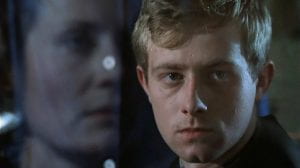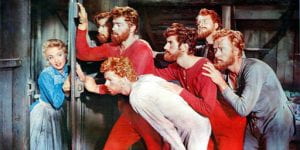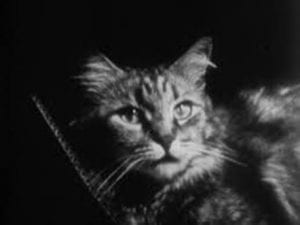Every month, A Place for Film brings you a selection of films from our group of regular bloggers. Even though these films aren’t currently being screened at the IU Cinema, this series reflects the varied programming that can be found at the Cinema and demonstrates the eclectic tastes of the bloggers. Each contributor has picked one film that they saw this month that they couldn’t wait to share with others. Keep reading to find out what discoveries these cinephiles have made, as well as some of the old friends they’ve revisited.
Be sure to join us for June’s round-up, which will be presented LIVE as a virtual event on June 8. Register now!
Jesse Pasternack, contributor | Dekalog: Six (1988) and Seven Brides for Seven Brothers (1954)
(Once a month, Jesse watches a double feature he calls the DekaDonen, which consists of an episode of Krzystztof Kieslowski’s miniseries Dekalog and a film by Stanley Donen. He’ll be watching and writing about these double features until October. Due to IU Cinema’s upcoming virtual edition of our Monthly Movie Round-Up, Jesse is switching up the order of the DekaDonen and will be talking about Dekalog: Five and Singin’ in the Rain — respectively one of the most famous episodes of Dekalog and the most famous film Donen directed — in June instead of this month.)
One of my favorite things about the DekaDonen is the opportunity it gives me to contrast differing takes on thematically similar stories. Both Dekalog: Six and Seven Brides for Seven Brothers are tales of male sexual obsession. But the tones of Kiewslowski’s episode and Donen’s film could not be more dissimilar from each other.
Dekalog: Six is about Tomek (Olaf Lubaszenko), a lonely teenager who is obsessed with an attractive older woman named Magda (Grazyna Szapolowska). Everything he does in relation to Magda — spy on her, get a job delivering her milk to be closer to her, forge letters so she can visit him at the post office where he works — is creepy. But things become complicated when Tomek tells Magda what he has been doing. Kieslowski does not shy away from the darkness of his story — or the satisfying nature of watching Magda humiliate Tomek — but he is also unafraid to explore the increasing complexity of their relationship as Tomek tries to apologize and prove that he loves her. Every technical aspect of this film’s style, from its cinematography by Witold Adamek to its eerie score by Zbigniew Preisner, supports its nuanced take on this complex central relationship.
Nuance and complexity are qualities that you will not find in Seven Brides for Seven Brothers. It is one of Donen’s most cheerful films. Certain sequences (especially the thrilling barn-raising dance sequence) are some of the best things Donen and choreographer Michael Kidd ever created. But Donen’s exuberant direction and the cinematography’s bright colors clash with the film’s casually terrifying story of six brothers kidnapping six women to become their wives. One musical number (“Sobbin’ Women”) features the eldest and at the time only married brother Adam Pontipee (a disturbingly upbeat Howard Keel) happily encouraging his six siblings to commit crimes by telling them the Ancient Roman story of the abduction of the Sabine women. Another musical number (“June Bride”) depicts the kidnapped women (who it is worth mentioning have forced Adam’s wife, Millie, to read them the story of the Sabine women multiple times) unironically expressing their Stockholm Syndrome in song before pursuing romantic relationships with their captors. It remains a film that boasts some of the best dancing and most startling gender relations ever committed to celluloid.
Comparing Dekalog: Six and Seven Brides for Seven Brothers can give you a masterclass in the importance of tone. Kieslowski’s serious, precise take on Tomek and Magda’s relationship is perfect for his disquieting story. In contrast, Donen’s deliriously entertaining technical style conflicts with the most disturbing elements of his film’s plot. It’s yet another example of how DekaDonen’s collection of masterpieces and misfires can function as a miniature film school.
You can view a trailer for Dekalog here.
Jack Miller, contributor | The Private Life of a Cat (1947)
I’m sad to say that, with the business of starting a new full-time job, I watched less movies than usual this month. But I did, thanks to the recommendation of a friend, take some time to catch up with the greatest “cat video” in the history of cinema: the American experimental work The Private Life of a Cat (1947), filmed by the great filmmaker Maya Deren and her husband/collaborator Alexander Hammid. The filmmaker Stan Brakhage, in his provocative way, used to say that Meshes of the Afternoon (1943) was really Hammid’s film, while Private Life of a Cat was really Deren’s. Certainly, the unusual editing rhythms and profound respect for animal life shown in this film must have influenced Brakhage.
The film follows a pair of male and female housecats as they mate, give birth to a litter, and begin to raise them. No humans are shown, giving this film an element of intimacy that makes it something special. Additionally, the birthing shots have a certain rawness not unlike those we see in Brakhage’s subsequent Window Water Baby Moving (1959). Cat obsessives and experimental film fans alike should be sure to check it out. While you’re at it, take my advice and double feature it with another auteurist cat film: Chris Marker’s deeply peaceful Cat Listening to Music (1988), in which Marker’s cat Guillaume-en-Egypte lays around on a keyboard while music plays softly in the background.
Deren and Hammid’s 22-minute film can be watched in its entirety here.
Laura Ivins, contributor | S He (2018)
A red, woman’s pump escapes imprisonment and impersonates a black, man’s loafer in order to save her child from forced masculinization and later starvation. Zhou Shengwei’s S He is object animation at is finest. In the popular examples of object animation that circulate the internet (PES’ inventive Western Spaghetti or clothes getting into fights on the floor), the objects themselves are somewhat incidental, often whimsical stand-ins for the things they represent, but not chosen to convey subtextual meaning.
With S He, however, every object, every material in every scene brings with it the cultural baggage of its original use, but transformed to give life to warring, abstract cultural concepts. A classic symbol of heterosexual femininity stands against a piece of masculine business attire. Green vines and fruit contrast gears and mechanics.
But S He is more than a critique of patriarchy; it is profoundly pessimistic that we could ever escape exploitation. Ultimately, whether feminization or masculinization prevail, still at the end nobody wins. The seductions of industrial production override everything, turning revolution into a capitalist nightmare.
Note: an English-language trailer couldn’t be found, but here is one in Chinese.
Michaela Owens, Editor | Clifford (1994)
Thanks to this month’s virtual TCM Film Festival, there were a lot of great films I was introduced to, like the sparkling Ernst Lubitsch silent So This Is Paris (still on HBO Max!) and the terrifically fun noir I Love Trouble. The latter film was my initial pick for this round-up, but then came the sad news that Charles Grodin, one of my low-key favorites, had died and I knew I had to instead go with a movie so absurd, it’s brilliant: Clifford.
I had first heard of this film earlier this year when Martin Short appeared on SmartLess, the podcast hosted by Sean Hayes, Jason Bateman, and Will Arnett, who couldn’t stop laughing as he told Short how he and Arrested Development creator Mitch Hurwitz often watch a specific clip from Clifford just because it is so hysterical. I was therefore thrilled when I saw that the film was part of TCM’s line-up on HBO Max. Starring a 40-year-old Martin Short as a 10-year-old, dinosaur-obsessed brat named Clifford, the movie is all about the havoc the boy wreaks on his uncle’s (Grodin) life simply because he wants to visit the fictional theme park Dinosaur World.
Short, of course, is unbelievably funny here, but you have to wonder if he’d shine as bright if it weren’t for Grodin. Despite the utterly ridiculous premise, the actor plays it as straight as possible and lets his signature deadpan style ground his character. As Clifford drives him to become more unhinged, though, Grodin’s increasingly crazed quest for revenge becomes a thing of beauty. We truly lost a great one.




